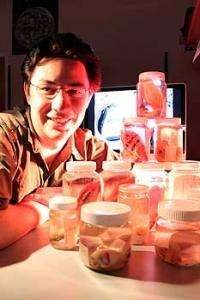Secrets of evolution extracted

Massey University's newest Maori PhD, Simon Hills, has taken shell collecting to a new level.
After spending five years amassing his own collection of sea snails to compare with their preserved and fossilised ancestors, his research has culminated in the development of a unique and comprehensive dataset.
Mr Hills, 32, whose doctorate will be conferred on Friday, says the collection provides a unique ability to document changes over time in the evolutionary history of the New Zealand sea snail – a marine mollusc known as Alcithoe.
Directly comparing changes of the DNA taken from his own collection and the national "wet collection" of sea snails, then integrating that with data from the fossil record, illustrated that the origins of the modern species are around 13 million years younger then the oldest known fossil specimens from the Duntroonian stage (between 27 and 25 million years ago).
His research was part of a project supported by a Marsden Fund grant to analyse and compare existing data about the sea snail evolution from the national fossil record with new DNA sequence data.
“My part of the project was sequencing the DNA and showing how it has changed over time. To extract DNA you take a piece of tissue, grind it up and mix it with a series of chemical solutions, then you end up with a sample of the DNA.
“This is the most comprehensive analysis of the evolution of a single genus using combined molecular and paleontological data that I am aware of and illustrates the advantage of having quality paleontological data to compare to emerging molecular data.”
He says New Zealand has one of the best fossil records of sea snails in the Southern Hemisphere, especially for animals that lived on the soft seabed from the tidal margin down to the edge of the continental shelf. “The thing about shells is they fossilise really well. Unlike birds, for example, that don’t tend to die in places where they fossilise – shells live in soft sediment on the ocean floor.”
While just a small part of the big picture of biodiversity in New Zealand, he says his research is a fundamental building block for future analyses. “The data I have collected is essentially a whakapapa or genealogy of these sea snails – they are endemic species, they only exist here, and evolved here. The data tells us how life has got to where it is now and how it might change in the future.”
Mr Hills says he always wanted to be a palaeontologist – “way before Jurassic Park” and excelled at biology at school before enrolling at Massey in 1997 and completing a Bachelor of Science majoring in biology, and then a Master of Science in genetics. It was a paper on evolutionary biology that led him to his path. “The trick with a PhD is to be excited about your topic. My academic record wasn’t that flash. Then I took a paper on evolutionary biology and that was it.”
Now that he has completed his PhD, the former Palmerston North Boys High pupil is looking at developing a project and sharing his knowledge about biodiversity with his father’s people of Ngati Porou from the East Cape.
Provided by Massey University


















